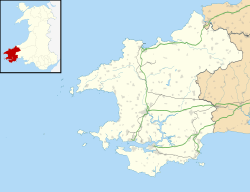Uses
The undercroft dates from the 14th or 15th century, and may have been an ossiary. In 1625 the building was referred to as a schoolhouse, and was used for this purpose until 1872. In 1833, the school educated 50 pupils, and 70 attended Sunday School. In 1846 it became a national school with up to 116 children until the village school opened in 1872. The building may have been used as a mortuary chapel, and is known by that name. After 1872, the building, which has a large blocked-up window, was used as a committee room, store and as a residence, housing paupers as late as about 1840. The building has been locally known as "The Oratory". Its current use is as a parish meeting room and Sunday School. [3] [4] S. Lewis, in 1833, describes the building: [5]
In the churchyard is an ancient building, apparently coeval with the church, which is occasionally used as a parochial school, the master being appointed by the vicar.
This page is based on this
Wikipedia article Text is available under the
CC BY-SA 4.0 license; additional terms may apply.
Images, videos and audio are available under their respective licenses.

